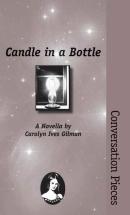Carolyn Ives Gilman is a name most fans of the genre will recognize. She’s appeared in nearly all the popular genre fiction magazines, and in 1992 she was a finalist for the Nebula award for her novella, "The Honeycrafters." As one would imagine from a series titled Conversation Pieces, Gilman writes Candle in a Bottle with a broad, intellectual style that suits the story and its message.
This lengthy, 100-page novella opens with two brothers, Gabriel and Dominique, making a dangerous trek on foot to Sorel. There, Gabriel means to consult the Oracle at the Institut Sorel, where he hopes to be accepted as an acolyte in the prestigious institution.
The "savants" of Institut Sorel compute the governing algorithms that give all things their shape and structure. In every aspect of life, nature, the universe, they see equations. Think of it in much the same way as how da Vinci mapped out the human body and found a set of repeating ratios. There are also "voyants" that work at the institution. They reap in mass quantities of data, information about the physical world.
Gilman has created an expressive and complex system of philosophy and science that her savants and voyants live in. This is the type of stuff a physics professor would enjoy. In this mass of multidimensional equations and boundless amounts of information, the savants have determined that the world is on the brink of a phase transition. This will kick the world into "order chaos" and possibly knock humanity back to its limited way of thinking in the 21st century.
Enter Dominique. He is recruited by the Institut instead of Gabriel and asked to watch for the random factor that will trigger the phase transition. Gilman’s Institut is built like the best Escher paintings. We read with wide-eyed wonder much in the same way Dominique first views his surroundings. And, indeed, Dominique figures out the random factor.
Perhaps many readers will find the novella to be cumbersome to read, to wrap your head around the imagery and science that Gilman presents. Hard science fiction fans will like it. Casual readers, not so much. Also, the characterizations didn’t draw the reader into much empathy. Obviously, the characters were second to the story and message, but I do believe it would have made Candle in a Bottle more accessible.
Interesting intellectual political intrigue, high-minded science, and a climax that moves along at a brisk pace makes the 100-page Candle in a Bottle a trip worth taking.
Paperback: 100 pages
ISBN: 1-933500-07-7
